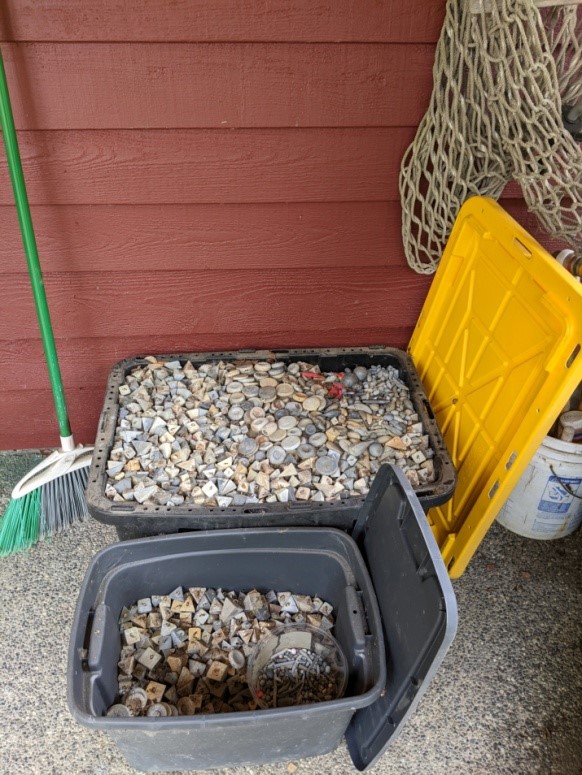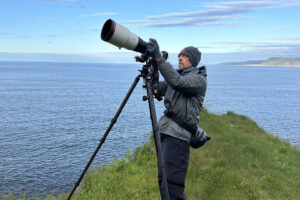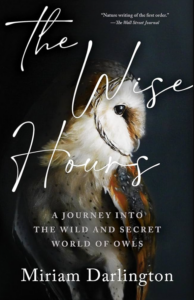By Doug Ewing, Pilchuck Audubon Society
I live near the Snohomish River in Snohomish County. More than 10 years ago, I began a daily habit to pick up litter along my river. I began to notice lost fishing weights in the shallow water. These range in size from tiny, spherical, “split-shot” weights that crimp onto the angler’s line to disk and pyramidal weights of 1 to 10 oz. each. All of these are made from lead. The more I looked, the more I found. Soon, I was sporting a face mask and diving. From just one-eighth of a mile, on only one side of the river, I have removed more than 3000 lbs. of lead. This should shock you. We are throwing tons of lead every year into what is left of what is wild -our rivers and lakes- and we are doing it in every state in the US. Today, fishing weights are the largest source of lead entering into the environment.
The dangers of lead to animals are well understood. Science tells us there is no “safe” level for human exposure. The toll on avian species is also well documented. The impact from fishing weights is perhaps greatest right now to waterfowl like loons, swans, geese, and ducks who are attracted to the small round weights to use in their crop to grind food. Still, tons of lead entering our rivers and lakes will eventually present hazards to species beyond waterfowl. I have not yet been able to determine the amount of lead entering the environment from fishing but the amount sold annually would be a good estimate. Eventually, all of this will be lost to rivers and lakes.
Recently, I have partnered with an organization called Green Snohomish to further our goal of spreading the word about this danger. People confess to never having thought of this problem. This allows a conversation about remedy. There are alternatives to lead, each with pros and cons. Lead has the advantage of being cheap, dense, easy to mold, and traditional. Options like steel, ceramics, etc., have downsides. I encourage anglers to learn about the true costs of lead. It is seriously toxic. It does not biodegrade. We simply must stop casting this eternal poison into our rivers and lakes.
Educating anglers is a start. Using lead alternatives is a start. Eventually, the only viable solution is legislation that bans the use of lead in fishing (and hunting) to eliminate the risk to wildlife. If you fish and still use lead, consider stopping. If you know people who fish, ask the same of them. Most importantly, when legislation is proposed, stand ready to contact your representatives. Won’t you help us?
Doug Ewing
360 809-0509
An article about my work: https://www.heraldnet.com/news/diving-for-trash-in-snohomish-river-biologist-fills-59-pickup-beds/
ADDENDUM: Tom Bowden, one of BHAS’s ardent supporters, passed along this information:
In Washington, the laws against the use of lead weights or jigs apply to the following lakes: Ferry Lake, Swan Lake, Pierre Lake, Big Meadow Lake, Yocum Lake, South Skookum Lake, Lost Lake, Blue Lake, Bonaparte Lake, Calligan Lake, Hancock Lake, Lake Hozomeen, and Long Lake.
There are many fly patterns that incorporate lead wire, beads, or eyes so they will sink faster. Many who tie flies, including Tom, now use substitute materials made of an alloy that doesn’t contain lead wire.
Tom has fished Long Lake in Eastern Washington over the years. It’s a fly-fishing-only lake with a ban on flies containing lead. There is a resident pair of breeding loons on the lake and they come right up to the boats – really fun to watch! The loons will dive for a fish after being released so people make a point of landing and releasing the fish quickly without tiring it out.
Photo credit: Photo by Doug Ewing of some lead he has removed from Snohomish River








